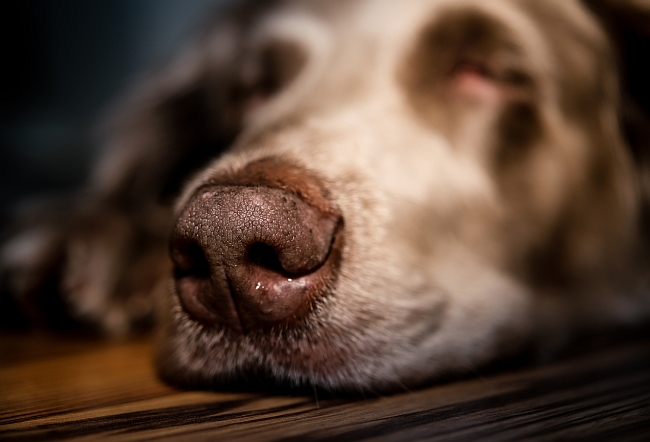
Dogs are extraordinary creatures with admirable skill sets that humans have learned to rely upon. Their ability to identify and pick up difficult scents, track and rescue lost people, as well as identify narcotics, have made them an invaluable resource. Out of all the aspects of a canine’s anatomy, it is the nose which we find most impressive. Find out more facts about a dog’s nose below:
Dog noses are powerful detectors. Dog cognition analyst Alexandra Horwitz of Barnard College describes the difference between a human nose and a canine nose this way: If a human can smell a cup of coffee and tell that there is a teaspoon of sugar added to it, a dog could identify that same scoop of sugar in over a million gallons of water. Consequently, it ought to be no surprise that dogs can detect fear in humans, an on-coming storm, and developing cancer.
They can change color. Like humans, dogs are susceptible to sunburns, which can cause the color of a canine nose to alter. Some breeds may also have their nose color change depending on the season and if they have regular contact with objects like plastic food bowls, or by digging incessantly.
Dog noses function differently than ours do. Humans have two nostrils that breathe in and out together, at the same pace simultaneously. Canine nostrils actually can inhale or exhale independently of each other, because of a tissues within the nostrils that actually separates the air into two pathways. One direction is used for olfaction (identifying scents, odor origin, identity and location), while the other direction is used for breathing/the respiratory system.
Dog noses are like fingerprints. The unique patterns, fissures, length, breadth and shape of a dog nose can actually be as varied and distinct as the human finger print. Some pet insurance companies even require a “nose print” for identification purposes.
A pup’s nose reflects his health. When a dog’s nose is very warm, he may have a fever, or be overheated. If a dog’s nose may indicate illness if it is dry, or if it is much wetter than usual or is dripping with mucus, he may be coming down with a virus or infection.
Humans are incredibly “smelly” to dogs. While humans work hard to mask certain unpleasant smells with perfumes, deodorants, lotions, and sweet-smelling soaps, the elements of our natural body odor are fascinating to a dog. They can detect the minor changes in the density and odor in our sweat, pheromones, and can smell every skin cell (of which there are over 50 million) that humans shed a day. This kind of sensory precision helps dogs with the ability to track people who have escaped or gotten lost.
Dogs use urine smells to identify and transmit messages to other dogs. The odor of urine communicates volumes to the canine nose. A dog can tell what gender the animal was, if they were ready to mate, or if there was a serious health concern, etc. This is why dogs like to “leave their mark” on tree trunks, poles, bushes, or on unfortunate public benches, to send a message to other curious canine noses in the park.
Bonus fact: Dog breeds with flat-laying squat noses (such as French Bulldogs, English Bulldogs, Pekingese, Boxers, Shih Tzus, and Pugs) are called brachycephalic breeds!
Note: If your dog’s nose is dry, cracked, or peeling from either sun damage, or is chapped from the cold or illness, produces like “Snout Soother” may help bring him some relief.
Helpful Learning-Aid Resource:
https://www.youtube.com/watch?v=p7fXa2Occ_U&feature=youtu.be&t=49s

